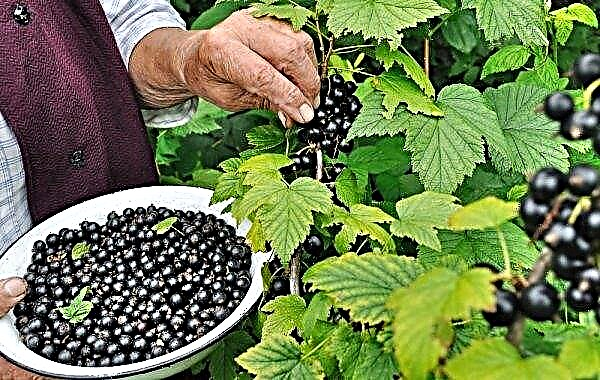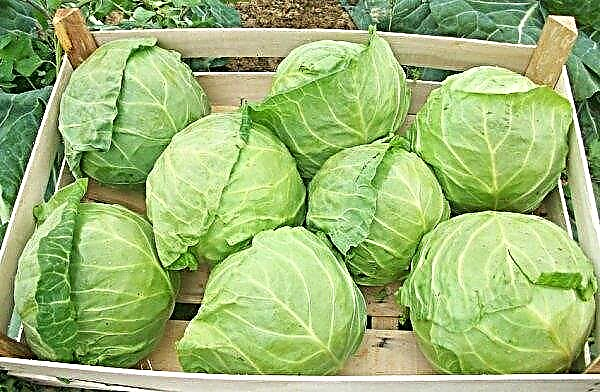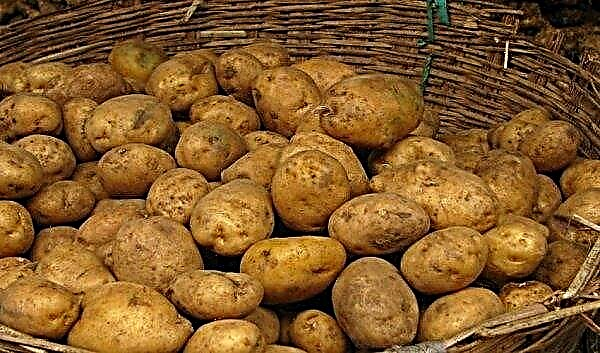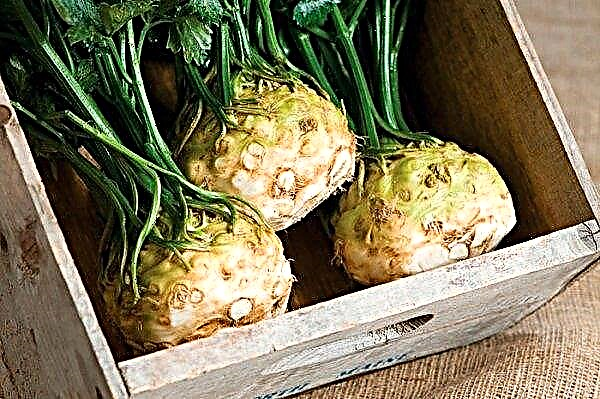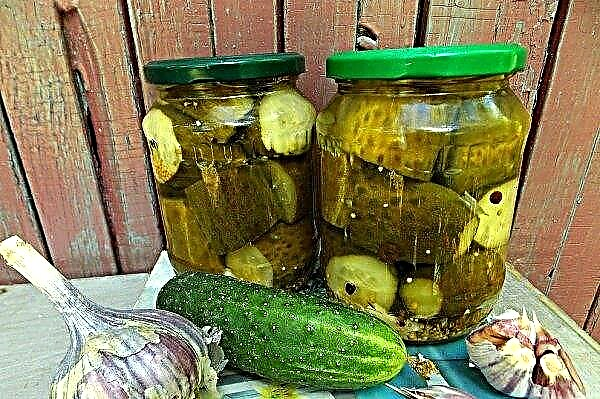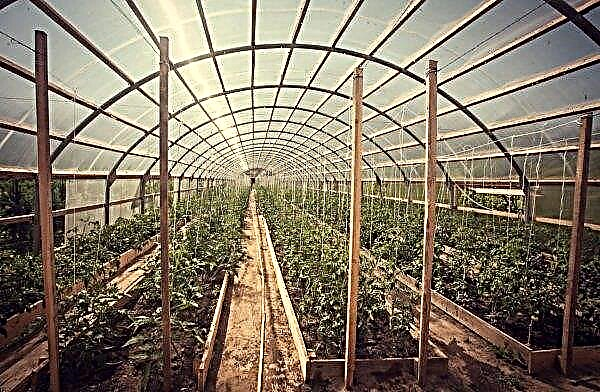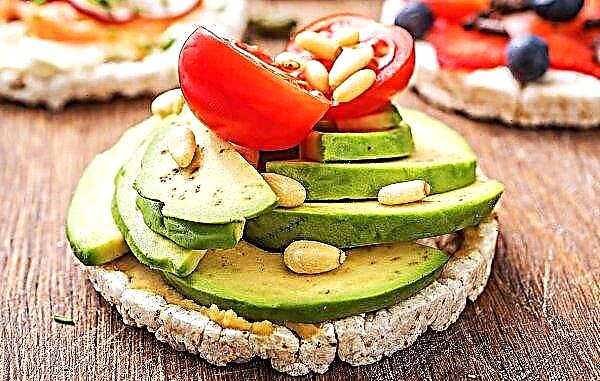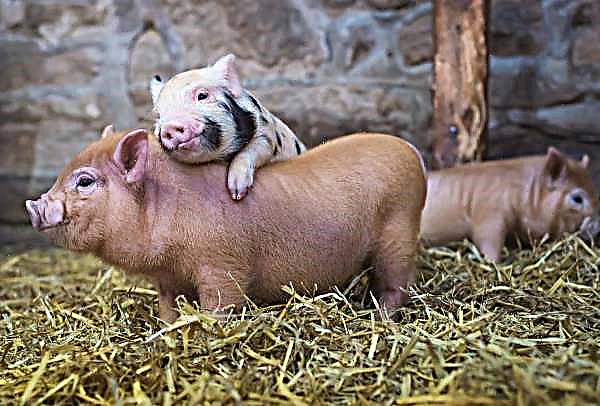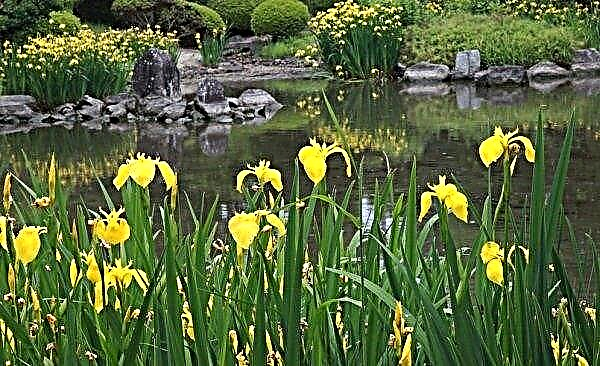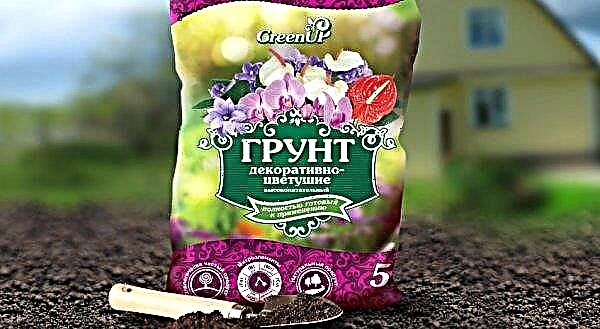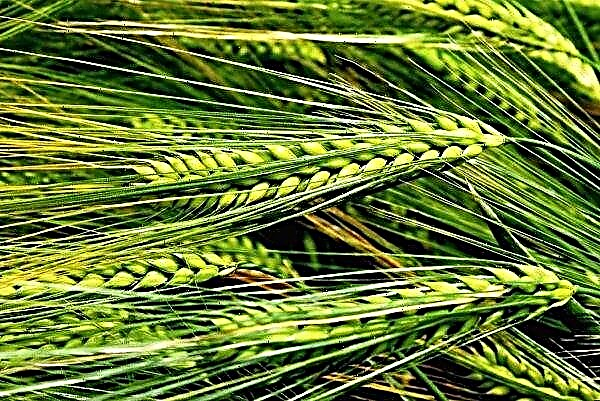Cherry is a decoration of any garden and the pride of its owner. However, this fruit tree is whimsical and can not grow in all regions and not in any area. We will talk about what needs to be done to get delicious yields of cherries Valery Chkalov in this article.
Description and characteristics of the variety
Cherry Valery Chkalov received joint efforts by Russian and Ukrainian breeders from the Caucasian Pink tree by free pollination. The authors of the varietal specimen appear S. Zhukov and M. Oratovsky. The result of the work of breeders was a variety with early flowering and fruiting, a high level of winter hardiness and fruits with taste characteristics that are as close as possible to the reference.
In the territory of Russia and Ukraine, this cherry tree has been planted for a long time. Since 1974, the variety entered the State Register. It is zoned in the North Caucasus region.
 The crown of the tree grows as it grows and becomes spherical
The crown of the tree grows as it grows and becomes spherical
Wood
Trees of the described variety grow tall - up to 5 m. Their crown is wide, sprawling, dense. The trunk is thick. The bark is rough, gray-brown. The main branches are located to the stem at an angle of 45-60 °.
The leaves are large, widely oval, with serrations along the edges. Their length is 19 cm, width is 10. The upper leaf plate is painted in saturated green color. The bottom is light green. The veins are relief, well marked. Leaves form on petioles 4.5–5 cm long.
Did you know? Cherry is one of the most beloved fruit trees in birds. Because of this, you can often hear its other name - bird cherry.
Flowering occurs in the early stages. Fruiting begins 5 years after planting a seedling in the ground.
Fruit
Fruits are formed large - 6-8 g each. In shape, they resemble hearts with a blunt tip. The skin and flesh are dark red. Inside there are pink streaks. The stone is large, round. Her weight is 0.4 g.
The pulp is characterized by juiciness and excellent sweet dessert taste with a slight sourness. According to the tasting scale, palatability was noted at 4.7 points. Berries hang from branches on strong stalks 4–4.5 cm long. They do not fall for a long time, even after full ripening. The fruits are consumed fresh and canned.
 Early ripening also plays a role - when most of the goodies are not yet available, a cherry crop already appears on the table, which does not have to wait long
Early ripening also plays a role - when most of the goodies are not yet available, a cherry crop already appears on the table, which does not have to wait long
Winter hardiness and disease resistance
Cherry trees tolerate cold temperatures well, quickly recover after them. The lowest indicators that do not have a detrimental effect on plants are up to –24 ° С.
Variety Valery Chkalov is considered hardy. However, it has one drawback - it is poorly resistant to infection with coccomycosis and fruit rot.
Pollinators
In order to get a plentiful harvest from cherries Valery Chkalov, it is necessary to plant pollinating plants in the garden. Such varieties include: Aprelka, Skorospelka, June early, Zhabule, as well as other cherries that bloom simultaneously with Valery Chkalov, or varieties of French selection.
Ripening period and yield
Fruits ripen in the early stages. Their mass collection is carried out in early June. Depending on the growing region, tree productivity ranges from 32 to 62 kg per plant. With the most favorable conditions and quality care, you can achieve a yield of 174 kg.
Video: Fruit bearing cherries Valery Chkalov
Growing conditions
To plant a cherry tree, you should choose a good site. It should be well-lit and sheltered from drafts. It is better to plant a seedling on a hill, natural or artificially created.
It is important to know the level of groundwater. They should not approach the surface of the earth closer than 1.5–2 m. Otherwise, rotting of the root system may be observed.
Did you know? Cherry is an ancient form of cherry. Man began to grow it about 8 thousand years BC. e. in the territory of modern Turkey. There it was discovered by the ancient Romans, thanks to which this fruit tree spread throughout the world.
Best of all, cherry trees grow and develop in loamy and sandy loamy soils, with good moisture and air permeability.
For planting, they acquire a one- or two-year-old seedling with a strong and well-developed root system, healthy in appearance, without spots and growths on the root neck, with a smooth bark. The trunk should reach a diameter of 1.5–1.6 cm. A pair of branches should be formed in a two-year-old specimen.
 The seedling should look healthy, and the cut under the skin should confirm this.
The seedling should look healthy, and the cut under the skin should confirm this.
Landing rules
The best time for planting is early spring, before the buds swell. In autumn, it is not recommended to plant cherries, as it is thermophilic and may not have time to adapt to winter cold. Autumn planting is possible only in the southern regions.
The site and the landing pit should be prepared in the fall. The landing hole should have a diameter of 0.8 cm, a depth of 0.7 cm. It is fertilized with humus (2 buckets), which is mixed with fertile soil.
Video: Cherry planting instructions
In the spring, mineral fertilizers are required to be introduced into the pit: superphosphate (300 g), potassium sulfate (100 g). If desired, you can add wood ash (1 kg).
The technology for planting cherry seedlings is as follows:
- In the center of the pit, set a stake for tying the trunk.
- Fill the hole 2/3 with fertilized soil, pouring it on the hill.
- Install a seedling on the hill so that the root neck is 5–7 cm above the edge of the pit.
- Spread the roots evenly on the ground.
- Fill the hole with fertilized soil to the brim.
- Tamp with light movements.
- Make an earthen shaft around the trunk to prevent water from spreading.
- Pour 2-3 buckets of water under the trunk.
- Mulch the near-stem zone with peat.

Cherry Care Features
A high-quality and abundant crop can be achieved from a plant by regularly watering, feeding, pruning, pruning, caring for the soil in the near-stem zone and taking preventive measures against infection by diseases and pests.
Watering
Cherry should be watered at least 4 times per season during such periods of development:
- before the appearance of flowers;
- after flowering;
- 20 days before harvesting;
- in October (water-charging).
Important! During the fruiting period it is impossible to water the sweet cherry. This can cause cracking of the skin of the berries.
If spring and summer are arid, then the number of irrigations should be increased by 2-3. However, it is important to consider that the cherry does not like excess moisture. Humidification should be moderate. It should be watered so that the soil in the near-stem zone is wet 30–40 cm in depth.
 Sweet cherry does not tolerate drought, but also does not like stagnation of water
Sweet cherry does not tolerate drought, but also does not like stagnation of water
Top dressing
In order for the tree to be healthy, strong and bear fruit well, it must be fed annually. Organic fertilizers can be applied once every 2-3 years. Minerals are required to be added annually. In spring and early summer, nitrogen is needed; in summer and autumn, phosphorus and potassium are needed.
For the first time, a young tree should be fed 3 years after planting. Until that moment, the elements that were added to the landing pit would be enough for him. At the first feeding, urea (120 g) is introduced for digging. Subsequently, it is applied in liquid form (20-30 g / 10 l of water) three times from early May to early June.
Important! Fertilizing is carried out only after rainfall or watering. Top dressing added to dry ground leads to burns of the root system.
From the fourth year, top dressing is introduced in late summer and autumn. During this period, superphosphate (300–400 g) and potassium sulfate (100–120 g) are used. In the fifth year of growth, ammofosku (30 g / 10 l) is used in spring, humus (20-30 kg / 1 tree) in autumn.
As soon as the first fruits appear on the cherry, they switch to spring top dressing with urea (200–300 g) and autumn compost, humus (40–50 kg) and superphosphate (400 g), potassium salt (200–300 g).

Soil care
Watering should be combined with important procedures such as loosening and mulching. Loosen the soil in the near-stem zone every time the earth is moistened by irrigation or rainfall. Do this a day after moisturizing. Loosening is necessary in order to avoid the formation of a hard crust on the surface of the earth, which prevents the access of oxygen and water to the root system.
Mulching is done to inhibit weed growth and retain moisture. It is important to timely clean the near-stem zone from weeds by weeding. Weed herbs pose a danger to cultivated plants, because they take away moisture, nutrients and are carriers of pathogens and pests.
 Dry grass, peat, sawdust, straw, and other materials are used as mulch.
Dry grass, peat, sawdust, straw, and other materials are used as mulch.
Pruning
Cherry pruning is carried out for several purposes: for the prevention of thickening and the development of diseases and pests, the formation of a certain form of crown, rejuvenation. Every year in the spring, it is necessary to remove diseased, dry, frostbite, deformed, branches growing deep into the crown.
The crown is formed in a plant that has been growing in soil for 5 years. In the first year of planting, one-year-old seedlings are cut to 50-60 cm, leaving 5-6 buds. In the second year, last year’s growth is shortened by a third, forming skeletal branches. Subsequently, branches of the lower tiers are formed in the same way. As a result, the tree will take the form of a pyramid.
 In subsequent years, only supporting clippings are required to remove abnormally growing shoots
In subsequent years, only supporting clippings are required to remove abnormally growing shoots
Winter preparations
Heat-loving cherries must be prepared for the winter. For this, several measures should be performed:
- whitewash;
- shelter;
- water-loading irrigation;
- mulching.
Water-charging irrigation is carried out in October. About one liter of water should be poured under one tree. This is necessary so that when the water freezes in the upper layers of the soil, the plant can be fed with moisture remaining in the depths.
Whitewashing is needed to protect the tree from diseases, pests, sun rays, frost pits, cracks in the bark. It is carried out with a special solution, which is purchased at the store or is made personally from lime-fluff (300 g), PVA glue (2 tbsp.) Or milk (0.5 tbsp.), Water (2 l), copper sulfate (1 tablespoon), dust (1 tablespoon).
In order for the tree to tolerate frosty temperatures, its trunk and root system should be covered. The trunk is wrapped with agrofibre, roofing felt, spruce branches, burlap. The near-trunk zone is mulched with peat in a layer of 30 cm.
 When preparing for the winter, it is important to provide the seedling with reliable shelter so that it can more easily survive the cold
When preparing for the winter, it is important to provide the seedling with reliable shelter so that it can more easily survive the cold
Pest and Disease Control
With disturbances during planting, as well as errors in agricultural technology, cherries can be affected by diseases and attack by harmful insects.
The table shows the problems that trees can comprehend, and how to solve them.
| Disease or pest | Symptoms of infection | Prevention measures and treatment methods |
| Moniliosis or fruit rot | Rotting berries, the appearance of beige dots on them. | Before the appearance of spraying flowers with the preparations "Fundazol" (10 g / 10 l of water), "Topaz" (2 ml / 10 l); after flowering - “Chorus” (3 g / 10 l). Pruning and disposal by burning diseased branches. |
| Coccomycosis | Small spots on the leaves, leaf fall. | Before the kidneys open, treatment with Bordeaux fluid (3%). In case of illness - spraying with means of “Skor” (2 ml / 10 l), “Chorus” (3 ml / 10 l). |
| Kleasterosporiosis | The appearance of spots on the foliage, the formation of holes on them. | Preparations “Khom” (40 g / 10 l), “Ridomil” (20 g / 10 l). |
| Aphid | Withering leaves from May to July. | Treatments with garlic infusion, Fufanon preparations (10 ml / 10 l), Confidor (1.5 g / 10 l), Fitoverm (1.5 ml / 10 l). |
| Mole | Damage to buds, flowers in May. | Processing on buds using Confidor (1.5 g / 10 L), Fitoverm (1.5 ml / 10 L). |
| Cherry fly | Damage to berries in May-June. | Actellik (2 ml / 2 L), Fufanon, (10 ml / 10 L), Karate (4 ml / 10 L). |
Harvesting and storage
Cherry is harvested when they turn dark red. For fresh food, berries are picked at full maturity, for conservation - 2-3 days earlier, for transportation - 5-7 days earlier. The peduncle must be green when harvested.
Important! Chemical treatments should be discontinued 40 days before harvest.
Fruits are torn off with hands or cut with scissors. The peduncle should remain on the berry. The fruits are stacked in plastic boxes. For storage lay only intact fruits. At a temperature of 0 ... + 0.5 ° C, the cherry can last up to 2 weeks.
 The yield of the variety is estimated to be average, but the concentration of fruits on the branches makes us think that things are much better
The yield of the variety is estimated to be average, but the concentration of fruits on the branches makes us think that things are much better
So, the variety of cherries Valery Chkalov has a number of positive characteristics, because of which its popularity among gardeners has not been falling for several decades. It is valued due to its delicious fruits, high fecundity, endurance, and frost resistance. With proper planting and proper care, the cherry tree will delight you with stable, plentiful and tasty harvests for 10-15 years.
Network user reviews:
ADVANTAGES: very beautiful, large and tasty
DISADVANTAGES: pests, like all cherries
I want to share with you one very delicious variety of cherries. It matures in our south of the Rostov region somewhere in early June. I really love this variety because it is large, sweet, with dense dark burgundy pulp. Ponytails come off with difficulty, which is also a plus for me. The trees of this variety are of medium size. If you follow the crown, then harvesting is not at all difficult. Unfortunately, I do not know the intricacies of stocks and scions, because I come across this variety as a consumer. In general, according to the owners of the garden, the variety is no different from other varieties of cherries. The most important problems are cracks after winter and worms that massively appear after rains. It is solved simply - you need to whiten the trunks and spray the trees in time.

